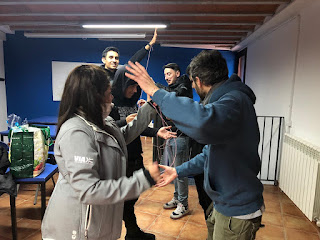The weekend started in La Salle where the bus picked us up and took us to Bagà. We arrived for lunch and after lunch we started with our activities. We did three different activities which had the purpose of reinforcing our international team.
The first one was the Infinity Rope which with only 1 material (rope) made us have so much fun. Basically, they were tied with the rope by pairs and they had to untie themselves. Seems pretty easy but it is more difficult than imagined. The pairs had to work together to try and get the best out of themselves too. They took almost 30 minutes to solve the riddle but it helped them to get to know others and exercise in solution finding. Also, developing resilience and communicating lessons.
The next activity was very easy since the rules were simple. This game was called 'Pepelitos' and consisted on pairs and a bucket full of paper with something written, it could be a place, food, celebrities or movies. The first round consisted on describing what the paper said without saying the word and your team had to guess it. The second round was a little bit more complicated since they had to say only one word and the team had to guess what the paper says. The third and most difficult one was to mimic what the paper said. As you can imagine, it was very funny since you just said random things to guess what was actually written in the paper.

The last activity was the most complex one and it was called Obstacle. The four of the students had to work together as a team to get through a bunch of obstacles. There was one student who was the leader, the other that had to be blindfolded who was the one to go across and the other two were the helpers. They had to lead the blindfolded team member through the obstacles and get to the finish line with only sounds. It could be a clap that meant go right or a whistle that means go forward. It was incredibly difficult but it helped increase team confidence. It was such a multicultural environment which led them to get to know how to work with people from different backgrounds and different opinions.
After all these games, we played a little bit of Jenga and laughed a little more. Afterwards, the Social Club prepared an activity for all of us. This was a party with drinking games and music. We had lots of fun and went to sleep for the next day. On Sunday morning, we left to do a hike in the woods. Nature there is so amazing since it is full of waterfalls and beautiful trees. After the hike we left back to Barcelona from this great weekend full of fun and team building.































